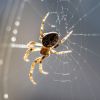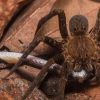-
 +19 +1
+19 +1Joro spiders aren’t scary. They’re shy.
Despite their intimidating appearance, the giant yellow and blue-black spiders spreading across the Southeastern U.S. owe their survival to a surprising trait: They’re rather timid. According to a new study from the University of Georgia, the Jorō (Joro) spider may be the shyest spider ever documented.
-
 +13 +1
+13 +1Three species of extremely primitive spider discovered in China
Mesothelean spiders diverged from all other spiders long before the first dinosaurs – three species of these living fossils have just been identified in western Hunan province
-
 +11 +1
+11 +1Huge spiders to colonize US East Coast, but maybe it's a good thing
Big and scary-looking Joro spiders have spread from Asia to the southern United States and are now poised to colonize the country's cooler climes—but they're nothing to fear and might end up actually helping local ecosystems. That's according to scientists who have been studying the arachnid invaders since they first arrived in Georgia around 2013.
-
 +17 +1
+17 +1Joro spiders likely to spread beyond Georgia
New research suggests the invasive but relatively harmless Joro spider could colonize the entire East Coast.
-
 +15 +1
+15 +1Spider Uses its Web Like a Giant Engineered Ear
Bridge spiders "outsource" their hearing by building webs that double as acoustic arrays, allowing them to perceive sounds from great distances.
-
 +12 +1
+12 +1This is the oldest fossil evidence of spider moms taking care of their young
Her corpse, preserved alongside her offspring in amber for 99 million years, is the oldest physical evidence for maternal care in spiders, says Paul Selden, an invertebrate paleontologist at the University of Kansas in Lawrence. This fossil is one of four showing that some ancient spiders guarded their egg sacs and may even have raised their young, Seldon and his colleagues report September 15 in Proceedings of the Royal Society B.
-
 +15 +1
+15 +1Scientists tweak daddy long legs genes to create daddy short legs
To some they're charming, to others they're creepy. But regardless of your feelings about the daddy long legs spider, odds are good you've seen the ubiquitous arachnid cruising up a wall or over its silky web somewhere. (And no, it's most certainly not capable of killing you.)
-
 +11 +1
+11 +1Jumping Spiders Seem to Have a Cognitive Ability Only Previously Found in Vertebrates
Tiny little jumping spiders, with their magnificent eyes, seem to be able to do something we'd only ever seen before in vertebrates: distinguishing between animate and inanimate objects.
-
 +14 +1
+14 +1Spiders eat snakes around the world, surprising study reveals
North American widow spiders, not tropical tarantulas, have a particular taste for reptiles, according to a sweeping analysis of data across six continents.
-
 +20 +1
+20 +1Scientists Confirm Certain Spider Bites Inject Something Even Worse Than Venom
A tiny brown invasive species of spider that's creeping its way across the UK has a dangerous reputation for dissolving flesh, one that many experts have argued isn't deserved.
-
 +18 +1
+18 +1Great Fox-Spider Assumed Extinct in UK Found at British Army Training Area After 27 Years
One of Britain's largest spiders, the Great Fox Spider, once thought to have gone extinct, has been spotted for the first time after 27 years at a Ministry of Defence training ground in Surrey. After being untraceable for more than a quarter of a century in the UK, finally this year the conservationists report the sighting of 22 Great Fox Spiders, including mature males and one mature female.
-
 +23 +1
+23 +1Some spiders may spin poisonous webs laced with neurotoxins
The sticky silk threads of spider webs may be hiding a toxic secret: potent neurotoxins that paralyze a spider’s prey.
-
 +14 +1
+14 +1Orb-weaver spiders’ yellow and black pattern helps them lure prey
Being inconspicuous might seem the best strategy for spiders to catch potential prey in their webs, but many orb-web spiders, which hunt in this way, are brightly coloured. New research finds their distinct yellow and black pattern is actually essential in luring prey. The findings are published in the British Ecological Society journal: Functional Ecology.
-
 +17 +1
+17 +1Scientists Demand 'Paradigm Shift' After Study Shows 'Frightening' Decline of Insects and Spiders
"A decline on that scale over a period of just 10 years came as a complete surprise to us," said one researcher, "but fits the picture presented in a growing number of studies."
-
 +2 +1
+2 +1Woman finds venomous brown recluse spider in her ear after complaining of earache
Susie Torres noticed a slight pain in her ear Tuesday morning. It was a venomous – but harmless – brown recluse spider.
-
 +31 +1
+31 +1Curious Kids: why do spiders need so many eyes but we only need two?
Human eyes are very complex and are good at doing many jobs at once, while spiders have different sorts of eyes that do different jobs.
-
 +26 +1
+26 +1Catapulting spider winds up web to launch itself at prey: study
Just when you thought spiders couldn't get any more terrifying.
-
 +5 +1
+5 +1Watch giant Amazon spider prey on opossum
This is the first video documentation of a large mygalomorph spider preying on an opossum. While surveying in northern Peru, a team of scientists from University of Michigan found a tarantula dragging a young opossum along the ground. The team was studying interactions between arthropods and small vertebrates in a lowland Amazon rainforest. The study found that arthropod predations accounted for a surprising amount of mortality amongst Amazonian vertebrates.
-
 +17 +1
+17 +1Infected ‘Zombie Spiders’ Forced to Build Incubation Chambers for Their Parasitic Overlords
Parasites that control the behavior of their hosts for their own benefit are a well-documented natural phenomenon, but the discovery of a previously unknown relationship between a parasitic wasp and a social spider is particularly upsetting.
-
 +36 +1
+36 +1Spider silk is five times stronger than steel—now, scientists know why
The next time you brush aside a spiderweb, you might want to meditate on its delicate strength—if human-size, it would be tough enough to snag a jetliner. Now, scientists know just how these silken strands get their power: through thousands of even smaller strands that stick together to form this critter’s clingy trap.
Submit a link
Start a discussion




















